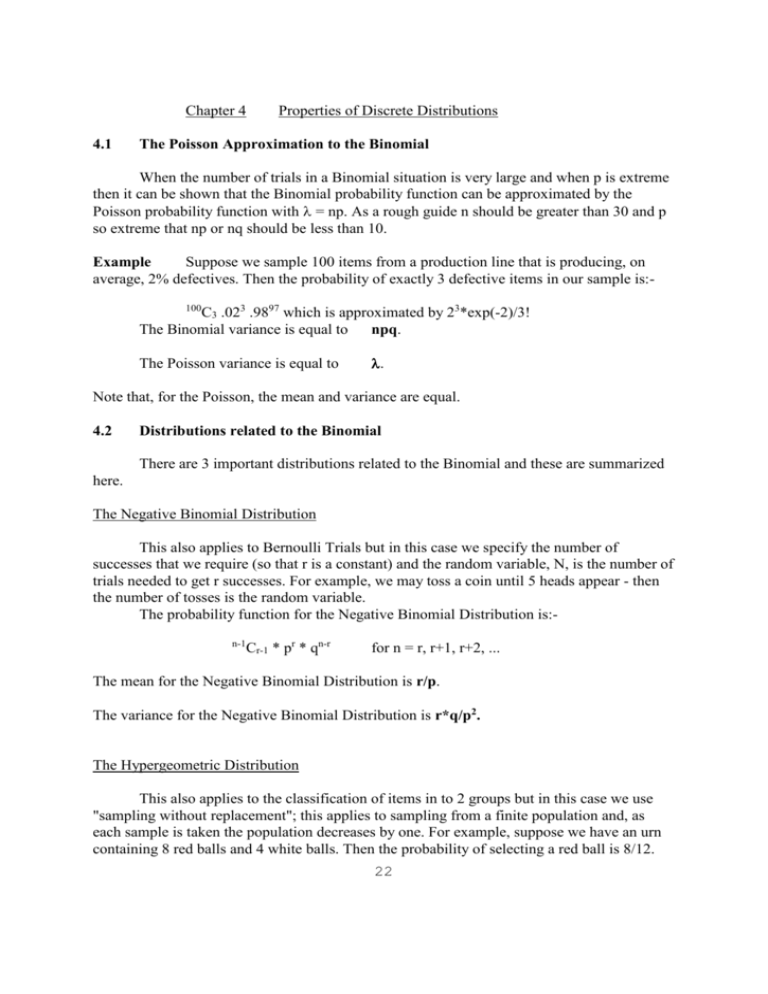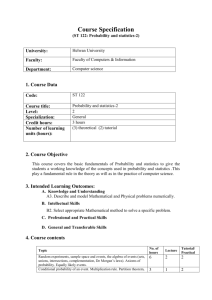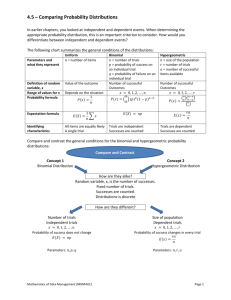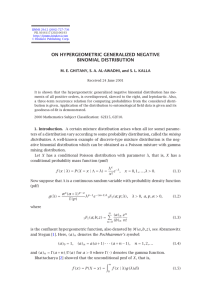CH4
advertisement

Chapter 4
4.1
Properties of Discrete Distributions
The Poisson Approximation to the Binomial
When the number of trials in a Binomial situation is very large and when p is extreme
then it can be shown that the Binomial probability function can be approximated by the
Poisson probability function with = np. As a rough guide n should be greater than 30 and p
so extreme that np or nq should be less than 10.
Example
Suppose we sample 100 items from a production line that is producing, on
average, 2% defectives. Then the probability of exactly 3 defective items in our sample is:100
C3 .023 .9897 which is approximated by 23*exp(-2)/3!
The Binomial variance is equal to
npq.
The Poisson variance is equal to
.
Note that, for the Poisson, the mean and variance are equal.
4.2
Distributions related to the Binomial
There are 3 important distributions related to the Binomial and these are summarized
here.
The Negative Binomial Distribution
This also applies to Bernoulli Trials but in this case we specify the number of
successes that we require (so that r is a constant) and the random variable, N, is the number of
trials needed to get r successes. For example, we may toss a coin until 5 heads appear - then
the number of tosses is the random variable.
The probability function for the Negative Binomial Distribution is:n-1
Cr-1 * pr * qn-r
for n = r, r+1, r+2, ...
The mean for the Negative Binomial Distribution is r/p.
The variance for the Negative Binomial Distribution is r*q/p2.
The Hypergeometric Distribution
This also applies to the classification of items in to 2 groups but in this case we use
"sampling without replacement"; this applies to sampling from a finite population and, as
each sample is taken the population decreases by one. For example, suppose we have an urn
containing 8 red balls and 4 white balls. Then the probability of selecting a red ball is 8/12.
22
We select a ball at random and it happens to be red and we do not return it to the urn. The
probability of the next ball sampled being red is now 7/11 and so the trials are not
independent as the probability of red at the second drawing is affected by the result of the first
drawing.
In general, if we have a population of N items made up of R "successes" and
(N-R) "failures" then the probability that a random sample of n contains r successes is given
by the Hypergeometric probability function,
a r b
{RCr * N-RCn-r} / NCn
where a = max (0, n-N+R)
b = min (n, R)
The mean for the Hypergeometric Distribution is nR/N.
The variance for the Hypergeometric Distribution is
nR(N-R)(N-n)/{(N-1)N2}
The Multinomial Distribution
This applies to the classification of items in to k groups and in this case we use
"sampling with replacement"; this also applies to sampling from an infinite population. It is
an obvious generalization of the Binomial from 2 to many classifications.
Let us suppose that we have k groups with classification probabilities, p1, p2, ..., pk and a
random sample of n items is taken. Then the random variables are R1, R2, ..., Rk representing
the counts of items falling in to each class.
Note that R1 + R2 + ...+ Rk = n.
Then the probability function for the multinomial distribution is the probability that
R1 = r1, R2 = r2 ..., Rk = rk which can be shown to be:n! / {r1! * r2! * ... * rk!} p1r1 p2r2 ...pkrk
where all the r's range from 0 to n subject to
r1 + r2 + ...+ rk = n.
The mean for r1 is np1, etc.
The variance for r1 is np1 * q1, etc.
Note that the marginal distributions of each of the R's is Binomial and that the Binomial is a
special case of the hypergeometric when k = 2.
23










